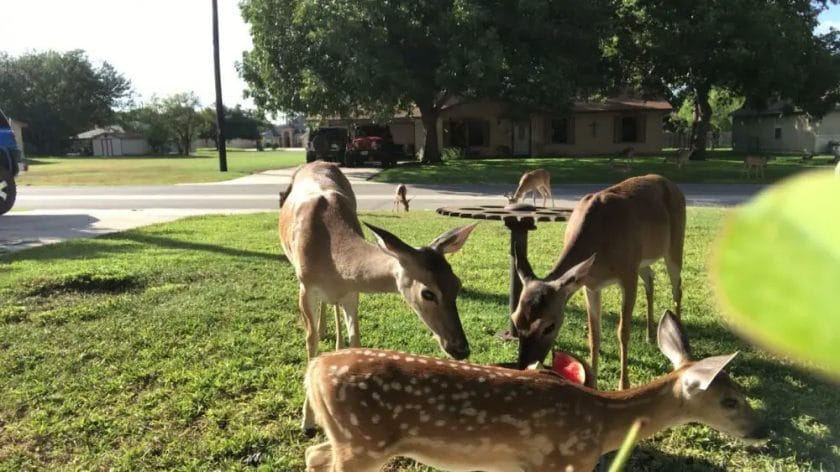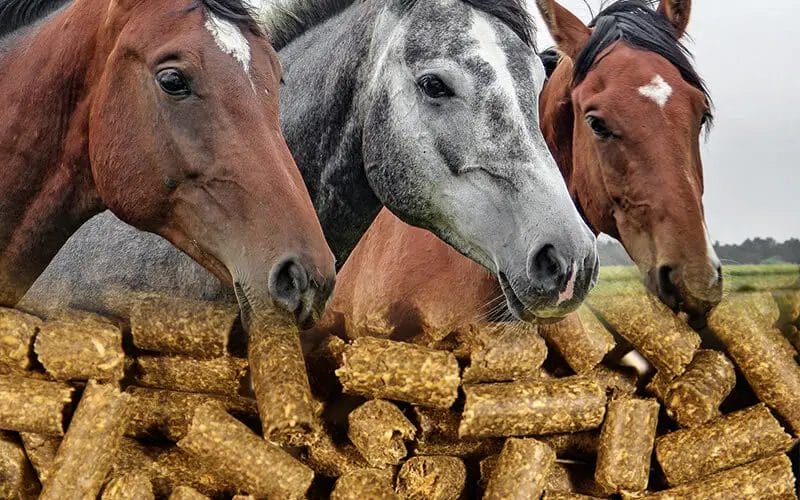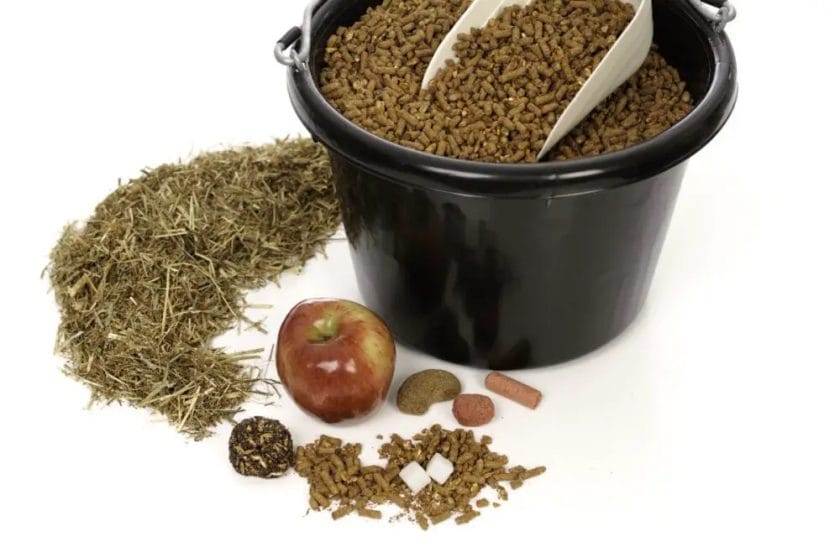Deer are primarily herbivores and their natural diet consists of plants, grasses, and leaves. However, in certain situations, deer may consume horse feed if it is easily accessible to them. The presence of grains, such as oats or corn, in horse feed can be attractive to deer. It is important to secure horse feed properly to prevent unwanted deer consumption and potential damage to the feed. Additionally, deer should not rely on horse feed as their main source of nutrition as it may not fulfill their dietary needs adequately.

Understanding the Feeding Habits of Deer and Horses
Feeding habits play an essential role in the survival and overall well-being of animals. In this section, we will delve into the feeding habits of two common herbivores: deer and horses. By understanding their dietary preferences and behaviors, we can gain insight into their ecological roles and how to best support their needs in various environments.
Dietary Preferences
Deer and horses are herbivores, meaning they primarily consume plant matter. However, their dietary preferences and the specific types of plants they consume may differ.
Deer
Deer are known to be selective browsers, meaning they carefully choose their food sources based on availability and nutritional value. While they have a broad range of plants they consume, their preferences often depend on the season and geographical location.
In the spring and summer months, deer tend to feed on tender leaves, shoots, and grasses. They have a keen ability to detect the most nutritious plants, guiding their selection. As fall approaches, they shift their focus to fruits, nuts, and acorns, building up fat reserves for the harsh winter ahead.
During winter, when food sources are scarce, deer resort to browsing on woody stems, tree bark, and evergreen vegetation. They can survive on these less nutritious options for extended periods but will eagerly search for fresh shoots and buds when available.
Horses
Horses, on the other hand, are grazers, which means they prefer to feed on grasses and other low-lying vegetation. Their digestive systems are uniquely adapted to process fibrous plant material efficiently.
While horses rely heavily on grass as their primary food source, they also benefit from consuming a diverse range of plants. This keeps their diet balanced and ensures they obtain all the necessary nutrients. Horses may consume leaves, herbs, and even the bark of trees if food is scarce, but their main focus remains on grazing grasses.
Feeding Behavior and Patterns
Aside from their dietary preferences, deer and horses also exhibit different feeding behaviors and patterns.
Deer
Deer are typically crepuscular, meaning they are most active during dawn and dusk. They have developed this behavior to avoid predators and take advantage of the optimal feeding conditions provided by low light levels.
When feeding, deer tend to move slowly and cautiously through their environment, carefully scanning for potential threats. They may browse on plants while standing or, in the case of taller plants, stretch their necks and stand on their hind legs to reach higher foliage.
Horses
Horses, on the other hand, are diurnal animals, meaning they are active during daylight hours. They have adapted to grazing throughout the day, utilizing their elongated necks and strong jaws to efficiently consume grasses.
Unlike deer, horses prefer to graze in groups, a behavior known as herd grazing. This behavior not only provides them with protection but also allows for social interactions within the herd. They will often move as a group, systematically grazing areas before moving on to new patches of grass.
Supporting Deer and Horses in Their Environments
Understanding the feeding habits of deer and horses is crucial for effectively managing their habitats and ensuring their well-being. Here are a few key considerations:
- Provide a variety of vegetation: Ensuring a diverse range of plants is available supports both deer and horses in obtaining the necessary nutrients for their diets.
- Preserve natural habitats: Protecting and maintaining natural habitats, such as forests and grasslands, provides essential food sources for these herbivores.
- Consider supplemental feeding: In regions where food sources may be limited, supplemental feeding programs can help support the nutritional needs of deer and horses.
- Monitor population densities: Regularly monitoring and managing population densities can prevent overgrazing and ensure the sustainability of food sources.
By implementing these measures and understanding the unique feeding habits of deer and horses, we can foster a harmonious relationship between these herbivores and their environments, promoting their long-term survival and ecological balance.

Potential Risks and Considerations When Deer Consume Horse Feed
Feeding horses is a common practice among horse owners and enthusiasts. However, it is important to be aware of the potential risks and considerations that arise when deer consume horse feed. While deer are primarily herbivores, they may be attracted to horse feed due to its availability and nutritional value.
1. Nutritional Imbalance
One of the main concerns when deer consume horse feed is the risk of nutritional imbalance. Horse feed is specifically formulated to meet the dietary requirements of horses and may contain ingredients that are not suitable for deer. Deer have different dietary needs and excessive consumption of horse feed can lead to an imbalance of nutrients, potentially causing health issues.
2. Digestive System Disruption
The digestive system of deer is adapted to process a diet consisting mainly of plants, such as grasses and shrubs. Horse feed, on the other hand, often contains ingredients that are foreign to deer’s natural diet. Consuming horse feed can disrupt the delicate balance of the deer’s digestive system, leading to digestive issues such as bloating, diarrhea, and discomfort.
3. Increased Risk of Disease
Another risk associated with deer consuming horse feed is the increased risk of disease transmission. Horse feed can act as a potential carrier of pathogens that may be harmful to deer. This can include bacteria, viruses, and parasites that are not naturally present in the deer’s environment. The introduction of these pathogens through horse feed can negatively impact the health of the deer population.
4. Competition for Resources
Feeding horse feed to deer can also lead to competition for resources between horses and deer. If horse feed is easily accessible to deer, they may consume it in large quantities, leaving less feed for the horses. This can result in malnutrition and weight loss for the horses, compromising their overall health and well-being.
5. Habituation to Human Presence
Feeding deer horse feed can also habituate them to human presence and alter their natural behavior. Deer that become accustomed to consuming horse feed may lose their fear of humans and become more dependent on artificial food sources. This can lead to increased interactions with humans, which can be detrimental to both the deer and human populations.
In summary, while it may be tempting to feed deer horse feed, it is important to consider the potential risks and implications. Nutritional imbalances, digestive system disruptions, increased disease transmission, competition for resources, and habituation to human presence are all potential consequences of deer consuming horse feed. It is crucial to prioritize the natural diet and habitat of deer to ensure their optimal health and well-being.

Effective Strategies for Preventing Deer from Accessing Horse Feed
Deer can be a nuisance when they enter horse pastures and consume the valuable horse feed. Not only can this lead to the depletion of feed resources, but it can also pose health risks to both horses and deer. Therefore, it is essential to implement effective strategies to prevent deer from accessing horse feed. In this section, we will discuss some practical and efficient methods that can help keep deer away from horse feed.
1. Secure the Feeding Area
One of the first steps in preventing deer access to horse feed is to secure the feeding area. This can be done by installing a sturdy fence around the feeding area. The fence should be at least 6 feet high to prevent deer from jumping over it. Additionally, make sure the fence is tightly secured to the ground to prevent deer from burrowing underneath it. Regularly check the fence for any damages and repair them promptly.
2. Use Motion-Activated Devices
Deer are skittish creatures that can be easily startled by sudden movements. Utilizing motion-activated devices such as sprinklers or noise-making devices can help deter deer from approaching the horse feed area. When a deer approaches, the device will activate, causing the deer to flee. This serves as a deterrent and discourages deer from returning to the area.
3. Implement Natural Repellents
There are various natural repellents that can be used to discourage deer from accessing horse feed. Plants with strong fragrances like lavender, rosemary, and garlic can be strategically planted around the feeding area. Deer find these scents unpleasant and are less likely to venture near them. Additionally, products containing predator urine or blood meal can also be sprayed around the perimeter to create a deterrent effect.
4. Secure Feed Storage
Properly storing horse feed is crucial to prevent deer from accessing it. Store feed in tightly sealed containers or bins that are inaccessible to deer. Avoid leaving feed bags or containers in open areas where deer can easily reach them. If possible, store feed in a locked shed or barn to ensure maximum security and protection.
5. Regularly Clean the Feeding Area
Deer are attracted to areas with food sources and scent markings. Regularly clean the feeding area to remove any leftover feed or spilled grains. This will help minimize the temptation for deer to visit the area. Additionally, consider using a rake or broom to remove any deer droppings or scent markings around the feeding area, as these can attract deer as well.
6. Encourage Natural Barriers
Creating natural barriers can be an effective way to prevent deer access to horse feed. Planting dense shrubs or thorny bushes around the feeding area can create a physical barrier that deer are hesitant to cross. Additionally, placing large rocks or fallen tree trunks strategically can also deter deer from approaching the feed area.
7. Install Lighting
Deer are more active during dawn and dusk when visibility is low. Installing motion-activated lights around the feeding area can help deter deer during these times. The sudden bright light can startle the deer and discourage them from approaching the area.
8. Consider Repellent Sprays
There are commercially available deer repellent sprays that can be applied directly to horse feed or in the vicinity of the feeding area. These sprays typically contain natural ingredients that emit odors that deer find repulsive. Regularly reapply the spray to maintain its effectiveness, especially after rainfall.
By implementing these effective strategies, horse owners can successfully prevent deer from accessing horse feed. This not only ensures the availability of feed resources for horses but also helps maintain a safe and healthy environment for both horses and deer. Remember to regularly assess the effectiveness of these strategies and make necessary adjustments to ensure optimal results.
Alternative Feeding Options for Deer in Areas Where Horses are Fed
Deer are magnificent creatures that roam freely in many areas, often sharing their habitat with other animals. In some cases, deer and horses may coexist in the same vicinity, leading to competition for food resources. Horses have different dietary requirements than deer, which can sometimes leave these graceful herbivores struggling to find adequate sustenance. However, with some careful planning and alternative feeding options, it is possible to ensure that both horses and deer thrive in these shared environments.
1. Food Plots
One effective way to provide supplemental food for deer in areas where horses are fed is by establishing food plots. A food plot is a designated area where specific plants are grown to attract wildlife, including deer. These plots can consist of various crops such as soybeans, corn, clover, or turnips, which are highly attractive to deer and meet their nutritional needs. By establishing food plots away from horse-feeding areas but within deer’s natural range, you can provide an alternative source of food, reducing competition and ensuring deer have access to a balanced diet.
2. Feeding Stations
Another option is to set up dedicated feeding stations for deer in areas where horses are fed. These feeding stations can be strategically placed away from horse-feeding areas to minimize competition. It is important to choose suitable feeders that can prevent the access of horses while allowing easy access for deer. Gravity-feeders or trough feeders with adjustable height settings can be effective in keeping horses out while providing a supplemental feeding option for deer. These feeding stations can be stocked with deer-specific food, such as pelleted feeds or specially formulated deer blocks, to ensure their nutritional requirements are met.
3. Timing and Rotation
Managing the timing and rotation of horse feeding can also help reduce competition and ensure deer have access to food. By feeding horses at different times or rotating the areas where horses are fed, you can create windows of opportunity for deer to access the leftover feed or forage. This ensures that deer have a chance to feed without the risk of encountering aggressive competition from horses. Additionally, establishing feeding stations or food plots close to horse-feeding areas can provide a convenient alternative while minimizing travel distances for deer.
4. Natural Forage Enhancement
An often-overlooked option is to enhance the natural forage available to deer in areas where horses are fed. This can be achieved by planting native grasses, legumes, and other wildlife-friendly plants that both horses and deer can graze on. By diversifying the vegetation and ensuring a healthy ecosystem, you can provide a natural feeding option for both species. It is important to choose plants that are not harmful to horses while providing adequate nutrition for deer.
5. Educating Horse Owners
Lastly, educating horse owners about the potential competition between horses and deer for food resources is crucial. Many horse owners may not be aware of the impact their feeding practices can have on local wildlife. By providing information on alternative feeding options and highlighting the importance of shared habitat conservation, horse owners can become valuable allies in creating a balanced and harmonious environment for both horses and deer.
In summary, ensuring that deer have access to adequate food in areas where horses are fed requires careful planning and consideration. Establishing food plots, setting up dedicated feeding stations, managing the timing and rotation of horse feeding, enhancing natural forage, and educating horse owners are all effective strategies for reducing competition and providing alternative feeding options for deer. By implementing these measures, we can promote the coexistence of horses and deer in shared habitats, allowing both species to thrive.
Will deer eat horse feed?
No, deer typically do not eat horse feed. Their natural diet consists of plants, leaves, grass, and fruits found in their environment. Feeding deer horse feed can be harmful to their health, as it may contain ingredients that are not suitable for their digestive system.
Conclusion
In conclusion, while it is possible for deer to eat horse feed, it is not their preferred food source. Deer are herbivorous animals and typically feed on plants, shrubs, and grasses found in their natural habitats. Although horse feed may contain grains and other ingredients that can be appealing to deer, it is important to note that it may not provide them with the necessary nutrients for their survival. Additionally, feeding horse feed to deer can disrupt their natural feeding patterns and potentially lead to nutritional imbalances. It is advisable to allow deer to forage for their own natural food sources and to avoid providing them with horse feed.
